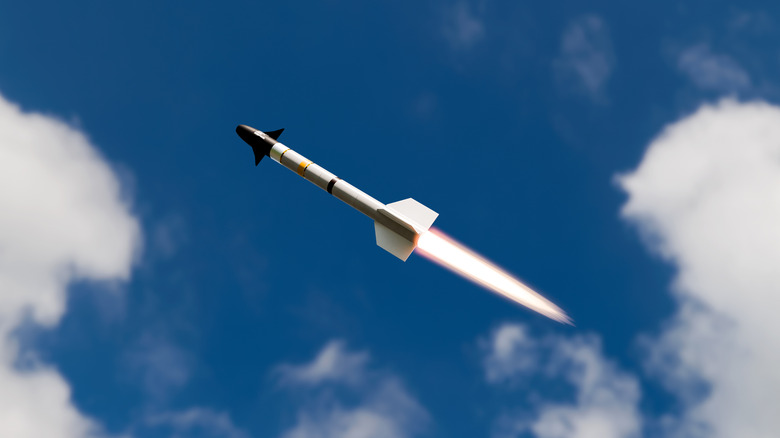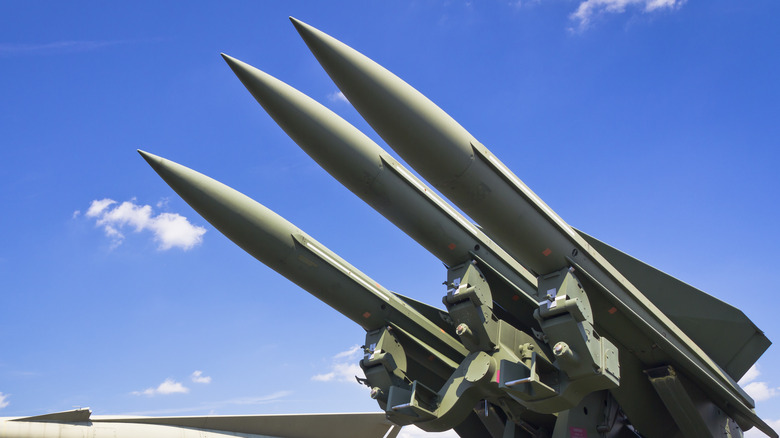How Do Heat-Seeking Missiles Avoid Locking Onto The Sun?
Throughout the centuries, weapons of war have evolved in remarkable yet terrifying ways. Battles that were once fought on the ground with swords and shields have taken to the skies, with fighter pilots duking it out within the clouds. Of course, the many intense dogfights in aerial history only became so thanks to the weapons involved. Take, for instance, the heat-seeking missile: an explosive projectile that locks onto infrared heat signatures, chasing pilots down with frightening accuracy. On the surface, this is some impressive technology, and it's even smarter than one might immediately think.
What prevents a heat-seeking missile from changing course to target the sun? It is a massive, super-heated, infrared radiation-emitting object, after all, so it might seem like a given that a missile would head straight for it instead of a comparatively cooler jet. Throughout the decades, such mishaps have been greatly mitigated by technology such as reticle-based missile systems. This targeting system uses a spinning mirror and optical system to eliminate interference, like the sun's rays. This ensures the missile locks onto a specific target and knows to follow its heat signature.
However, before it became something for military weaponry to avoid, attempts were actually made to use the sun to guide missiles. Unfortunately, such efforts only amounted to failure.
The sun could've helped missile technology
Warfare in the skies really picked up beyond the First and Second World Wars. With the Cold War looming, the United States military further explored aerial combat technology to find innovative ways to take out enemy targets. Thus, the Sun Tracker was born. It was an experimental piece of tech that utilized the Sun to help missiles find their targets, detecting different light intensities at varying altitudes. This sensor, theoretically, would help missiles skirt around ground jammers, which disabled radio and radar-guided missiles deployed in their vicinity. While a good idea in theory, its testing led to a near disaster for the U.S. government.
Come 1948, the Sun Tracker had reached the testing stage, being equipped on a B-29 bomber — one of many notable craft in the grand history of the jet age — for flight on July 21. Captain Robert Madison took flight in Inyokern, California, only to go down due to his own error over Lake Mead. Three of the four engines were torn from the aircraft, with the fourth catching fire. Luckily, Madison completed the landing safely, with only one casualty. Beyond this, little else is known about the device, with its Sun Tracker name even being a source of debate all these years later. Suffice it to say, the invention didn't quite catch on.
Seeing as the Sun Tracker project was abandoned, it's fair to say that using the sun to guide missiles was never meant to be. Now, it remains something heat-seeking missiles need to avoid, along with other potential distractions.
Heat-seeking missiles have to ignore more than just the sun
Contrary to what a cursory study of heat-seeking missiles might suggest, these dangerous weapons aren't perfect. Yes, they have been improved upon throughout the years to avoid hopeless pursuits of the sun, but they're still not a guaranteed hit. They can encounter other distractions that prevent them from hitting their targets. For instance, clouds can reflect sunlight and create signatures that divert missiles. Ground-based objects such as smoke-emitting chimneys, reflective surfaces like windows, and even water can have the same effect, hence the implementation of reticle systems.
As if these neutral elements weren't troublesome enough for pilots hoping to use heat-seeking missiles, countermeasures are also quite effective distractions in their own right. Pilots pursued by a heat-seeking missile can release flares to make a quick escape. These jettison and give off a hotter signature, which sends the missile after them instead of the jet. Meanwhile, the pilot zips away to stay out of the missile's line of sight. Directional Infrared Countermeasures, or DIRCMs, have also become more prominent. These utilize a movable laser to shut down a chasing heat-seeking missile's infrared tracking system.
As necessary as the Sun is for life on Earth, it's not all positive. As established, it can be a distraction for heat-seeking missiles, though advanced technology has made this far less of an issue than ever before. Now, if only our best and brightest could do something about the fact that a single Sun explosion could bring a swift end to the digital age...


